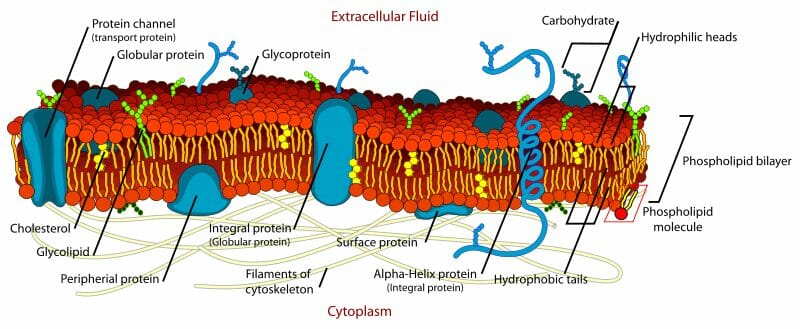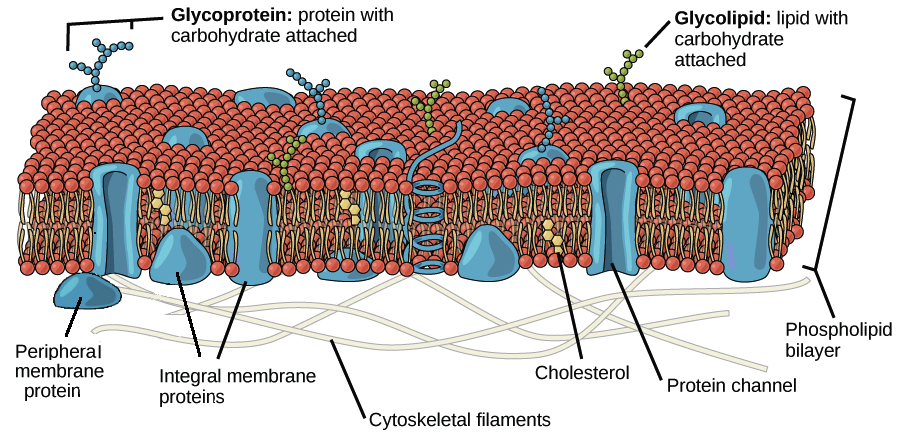3Which statement correctly describes the function of pumps in the plasma membrane. Describe the fluid mosaic model of plasma membrane.

2 1 5 Plasma Membrane Structure And Function Youtube
Median response time is 34 minutes for paid subscribers and may be longer for promotional offers.

. A phospholipid is a lipid made of glycerol two fatty acid tails and a phosphate-linked head group. The membrane is mainly composed of lipids proteins and carbohydrates. -Selectively permeable double membrane barrier containing pores-Encloses jellylike nucleoplasm which contains essential solutes-outer membrane is continuous with the rough ER and is studded with ribosomes-Inner membrane is lined with the nuclear lamina which.
Proteins are wedged between the lipids that make up the membrane and these transmembrane proteins allow. Cell wall A structure that surrounds the plasma membrane of plant and fungus cells and provides additional support to those cells. Plasma membranes range from 5 to 10 nm in thickness.
Structure of the plasma membrane as a mosaic of components including phospholipids cholesterol proteins and carbohydratesthat gives the membrane a fluid character. The plasma membrane is the outer limiting membrane of a cell that separates the bodys two major fluid components the intercellular fluid that is within cells and the extracellular fluid outside of cells. Water makes about 29 of total weight.
Which of the following statements best describes the chemical composition of plasma membrane. Phospholipid is composed of four components such as al View the full answer. Experts are waiting 247 to provide step-by-step solutions in as fast as 30 minutes.
The cell membrane is primarily composed of a mix of proteins and lipids. Plasma Membrane Components. Depending on the membranes location and role in the body lipids can make up anywhere from 20 to 80 percent of the membrane with the remainder being proteins.
Plasma Membrane Structure Phospholipids. These proteins form channels to allow the movement of large molecules and ions across the. Describe the composition of the plasma membrane The plasma membrane surrounds all cells and contains a semifluid substance called cytosol it also contains chromosomes and ribosomes.
The plasma membrane also known as the cell. Answered Which statement best describes the function of the plasma membrane. Describe the fluid mosaic model of membrane structure and identify the types of lipids typically found in bacterial membranes.
The plasma membrane is an extremely pliable structure composed of 2 layers of back-to-back phospholipids a bilayer. A single phospholipid molecule has a phosphate. The membrane is partially made up of molecules called phospholipids which spontaneously arrange.
Phospholipids forms the ultimate fabric of the membrane. This membrane is composed of two layers of lipid or fat molecules phospholipids in particular with the water-repelling tails of these m. Robertson 1959 proposed that plasma membrane is three-layered structure where proteins form the outer and inner layers of membrane that encloses lipids to form a.
Cholesterol folded between the hydrophobic tails of phospholipid membrane. Carbohydrates are also. Its main function is to protect the cell from its surrounding and is composed of a phospholipid bilayer with embedded proteins.
The proportions of proteins lipids and carbohydrates in the plasma membrane vary with cell type. Among the most sophisticated functions of the plasma membrane is the ability to transmit signals by means of complex integral proteins known as receptors. The Plasma Membrane of a cell is composed of a Lipid Bilayer with Proteins embedded in it.
There are various proteins embedded within the membrane that have a variety of functions. Response times may vary by subject and question complexity. The Plasma Membrane formerly known as the cell membrane forms the border of a neuron and acts to control the movement of substances into and out of the cell.
The principal components of the plasma membrane are lipids phospholipids and cholesterol proteins and carbohydrate groups that are attached to some of the lipids and proteins. Depicts the plasma membrane as exceedingly thin 7 - 10 nm flexible structure composed of a double layer or bilayer of lipid molecules with protein molecules plugged into it. - Basic structure according to fluid mosaic model.
Plasma membrane structure Click card to see definition surrounds the cell contains the organelles protects and separates the inside of the cell from the outside allows and controls the passage of substances inout of the cell Click again to see term 145 Previous Next Flip Space THIS SET IS OFTEN IN FOLDERS WITH. Previous question Next question. Plasma membranes separate the cell from its environment while other membranes define the boundaries of organelles and provide a matrix upon which complex chemical reactions can occur.
It is very thin about 7 to 10 nm and is composed of a bilayer of lipid molecules with proteins dispersed in it. The hydrophobic region of the lipid bilayer core excludes water whereas the Hydrophilic regions both inside and outside of the cell allow water to be drawn into the structure through osmosis. Want to see this answer and more.
These are found embedded in a single leaflet of the membrane. Peripheral proteins present on the outer or inner surface of phospholipid bilayer but are not implanted in the hydrophobic core. They carry signals from one.
Describe the lipid composition and distribution of plasma membrane. Its rigidity does not allow materials to enter the cell C. To perform these roles the plasma membrane needs lipids which make a semi-permeable barrier between the cell and its environment.
The correct option is d. These proteins act both as receivers of extracellular inputs and as activators of intracellular processes. Membranes are lipid structures that separate the contents of the compartment they surround from its environment.
Plasma membrane is a phospholipid bilayer which consists of polar head facing outward and hydrophobic tail facing inward. These membrane receptors provide extracellular. Cholesterol is also present between the phospholipids which contributes to the fluidity of the membrane.
It also needs proteins which are involved in cross-membrane transport and cell communication and carbohydrates sugars and sugar chains which decorate both the proteins and lipids and help cells recognize each.

Structure Of The Plasma Membrane Article Khan Academy

Plasma Membrane Definition Structure Functions Biology Dictionary

How To Describe The Molecular Structure Of The Plasma Membrane Quora
0 Comments